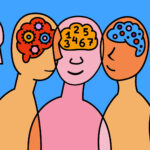Can a New Diagnosis Help Prevent Suicide?
One night in her Nashville apartment, Bre Banks read a comment from her boyfriend on Facebook. They were in a shaky spell, and his words seemed proof she would lose him. She put her laptop down on the couch and headed to the bedroom to cry. “My legs seized up, and I fell,” she recalled. With her knees and forehead pressing into the carpet, she heard a voice that said, “Slit your wrists, slit your wrists.” She saw herself in the bathtub with the blood flowing. She was terrified that if she moved she would die.
Banks, then 25, was a disciplined graduate student with a job and close friends and had no psychiatric history. “I had never considered suicide an option,” she says. But for the next three days, she couldn’t sleep while the voice and disturbing images persisted. After seeing a therapist, she decided to teach herself techniques from dialectical behavior therapy, one of the few treatments shown to reduce suicidality. The voices and images came back over the next few months, but eventually faded. Eight years later, Banks now evaluates suicide prevention programs across Tennessee as a manager at the large mental health provider Centerstone’s research institute, and she and the same boyfriend just celebrated their 10th anniversary.
In the public imagination, suicide is often understood as the end of a torturous decline caused by depression or another mental illness. But clinicians and researchers know that suicidal crises frequently come on rapidly, escalating from impulse to action within a day, hours, or just minutes. Many also point to the fact that they may strike people like Banks, who are otherwise in good mental health.
That understanding is one reason a movement is building to define suicidality as a condition in its own right. Most recently, researchers from Mount Sinai Beth Israel and Florida State University have agreed to collaborate on a joint proposal for a new diagnosis in the next Diagnostic Statistical Manual of Mental Disorders (DSM), a handbook published by the American Psychiatric Association. The criteria include familiar symptoms of depression, but these symptoms occur in an acute state that is not currently obvious to clinicians. Proponents say it could spur more research and make it easier for suicidal patients to get the care they need.

Researchers are collaborating to include a new diagnosis for suicidality in the next edition of the Diagnostic and Statistical Manual of Mental Disorders, a handbook published by the American Psychiatric Association.
Some have expressed skepticism. “Far too many diagnoses in psychiatry come and go,” said George Makari, a Weill Cornell Medicine psychiatrist and historian of psychiatry. The idea that suicidality may not be a symptom of something else — a mood or personality disorder — is novel. “If they’re making the claim that we’ve been seeing this upside down for a long time,” he said, “that’s fascinating.”
Suicide rates have been rising sharply since 1999, figures from the Centers for Disease Control and Prevention (CDC) show. More than half of those who take their lives do not have a known mental health condition. There is also no established way to pinpoint when a patient is in immediate danger. “You cannot rely on people telling you when they are or are not suicidal,” said Igor Galynker, a professor of psychiatry at Icahn School of Medicine in New York.
Research backs that up: A 2019 meta-analysis of 71 studies conducted around the globe found that about 60 percent of people who died by suicide had denied having suicidal thoughts when asked by a psychiatrist or general practitioner. Here in the U.S., a 2016 study examined data from four health systems that use standardized questionnaires in primary care and specialty clinics. (The questionnaires ask whether the patient has experienced “thoughts that you would be better off dead or of hurting yourself in some way.”) Although the answers did predict future suicide attempts to some extent, there were plenty of false negatives. Thirty-nine percent of the suicide attempts and 36 percent of the suicide deaths occurred among patients who had responded “not at all” to the key question. In another study, about a quarter of the suicide attempts were made by people who reported zero suicidal thoughts.
It’s easy to assume they were lying, but that’s not quite true. Greg Simon, a psychiatrist and investigator at Kaiser Permanente Washington in Seattle, who led the 2016 study, was involved in a follow-up study based on interviews with 26 people who had made attempts after denying any suicidal thoughts on the standard questionnaire. The interviews revealed that some people had lied, he said. But they also revealed people who had provided “aspirational” responses — they were trying not to have suicidal thoughts — and people who had experienced no suicidal thinking whatsoever. (Among the latter group, alcohol often factored into their attempts.) None of them woke up that morning with a plan to die that day.
For his part, Galynker determined long ago — after he lost a patient who took him by surprise — that he couldn’t rely on patient reports. In 2007, he set out to develop a set of symptoms that would help pinpoint imminent suicide — even if the patient didn’t report suicidal thinking. “We hypothesized that the pre-suicidal state leading to suicidal action was short-lived, kind of like pulling a gun trigger,” he said. In 2009, he called it “suicide trigger state.” Over dozens of research papers, he explored various symptoms as predictors, developing checklists and then testing how well they predicted future behavior. While these checklists are still new, they are being used to screen for suicidal risk among high school students in Moscow, Russia, and among hospital patients in Chicago.
In 2017, Galynker coined the term “suicide crisis syndrome.” People with this syndrome feel trapped, though they might not think of death per se. They may be flooded with misery and unable to think clearly. Certain thoughts, like Banks’ images and voices, return repeatedly, no matter how much they are resisted. They may experience mood swings or overwhelming emotional pain.
At Florida State University, Thomas Joiner, the author of several books on suicide and the editor of a suicide journal, outlined his own criteria for a quick-onset suicide crisis, which he calls “acute suicidal affective disturbance.” This describes rapidly escalating plans for suicide over hours or days — faster than clinicians may expect. The key difference is that Joiner includes reports of suicidal thinking as an essential criterion.
The pair teamed up more than two years ago when the first paper describing both of their diagnoses appeared. Together, the two researchers envision a new DSM suicide diagnosis with two sub-types, one with thoughts of suicide, and one without. Before this diagnosis is approved for the DSM, however, the researchers may need to show more conclusively that the phenomenon they describe isn’t a symptom of depression or another mental illness, and that their methods of screening for it are effective.
Psychiatrist Michael First at Columbia University, who presided over earlier revisions of the DSM, sees a suicide-specific diagnosis as an “appealing idea.” If the melding of Galynker’s and Joiner’s formulations worked well and proved to be accurate, First said, “then it would clearly be very useful to have it.”
Clinicians currently struggle with little guidance on how to identify imminent risk or make sense of suicides that seem to come out of the blue.
Nearly once a week, attending psychiatrist Dmitriy Gekhman at Mount Sinai Beth Israel sees a patient who has attempted suicide and is hard to classify, though he must find a relevant code for each patient’s chart. “You kind of go through the history and everything, and they’re not depressed. They don’t meet the criteria for depression, they don’t meet criteria for bipolar disorder, and they don’t have a personality disorder,” he said. “We just discharged somebody this week who that happened to, and we still have somebody on the unit now.”
If a diagnosis based on Galynker’s and Joiner’s research were put in place, it would put the patient’s doctors on notice that the patient is a risk for suicide with rapid onset. Over time, it’s possible that clinicians and even teachers and parents would become better at seeing the signs. The diagnosis, Joiner explained, is a “warning sign for the future.”
Detroit’s Henry Ford Health System provides a glimpse of how suicide prevention might evolve. At Henry Ford, suicide is considered its own mental health category, not primarily a symptom of depression. In 2002, the health system began a series of initiatives, and reduced patient suicide rates a dramatic 80 percent over the next seven years.
The staff at Henry Ford discovered that from 2000 to 2010, only half of patients who died by suicide had received a mental health diagnosis, closely matching current national statistics. This could be undiagnosed illness, “but I think a lot of people don’t meet the criteria,” said Brian Ahmedani, who directs the health system’s Center for Health Policy & Health Services Research.
Henry Ford screens everyone with questionnaires asking about suicidal thoughts, a practice the Joint Commission, which certifies health care organizations, started recommending in 2016. But in its behavioral health units, the risk assessment focuses on triggers, such as a job loss. Ahmedani says that patients in the highest risk percentile usually have a number of triggers: chronic pain, opioid use, and insomnia, for example. Because assessing the many possible combinations can be difficult, Henry Ford uses artificial intelligence to analyze electronic medical records, helping clinicians who may not have time to catch a perfect storm before it’s already too late. Veterans are a high-risk group, so the Veterans Affairs (VA) has begun using these algorithms too.
Currently, suicidal people are often prescribed antidepressants. However, other than lithium, most often used to treat people with bipolar disorder, there’s little evidence that medication prevents suicide, Ahmedani observed. New VA clinical guidelines also support short-term infusions of a drug called ketamine.
Henry Ford offers treatments specific to suicide: identifying triggers and coping mechanisms, for example. It also offers cognitive behavioral therapy and dialectical behavior therapy, the treatment that helped Banks. Patients are encouraged to develop a safety plan that includes removing guns or painkillers from the home, and an idea of who they might call under duress.
David Covington, a suicide prevention activist, said, “we used to think that if you treat addiction, the mental health will get better, and the other side thought if you treat mental health, the addiction will get better. Now we say you have to treat both.” Similarly, a person might need treatment for both suicide and depression.
The new diagnosis, more fundamentally, could change who we think might be driven to the extreme of a suicide attempt. Psychiatrists still refer to suicide attempts with a short buildup as “impulsive,” but Joiner’s team disputes that these are impulsive people. Megan Rogers, a Ph.D. candidate who works with Joiner, sees outpatients at the university clinic. She recalls one who “within hours would go from no risk to high risk” but had what she describes as a “conscientious and vigilant,” rather than impulsive, personality.
Still, some question whether a new diagnosis would actually benefit patients. For one thing, it isn’t clear how such a diagnosis would influence treatment — or whether it would save lives. “There is simply no value in a prediction that cannot lead to an effective preventative measure,” writes psychiatrist Matthew Large in a 2018 paper evaluating suicide assessment approaches generally. More people could land in hospital psychiatric care, or be kept longer than they desire, he said. And “while it is generally assumed that hospitalization can prevent suicide, this has never been demonstrated empirically.” In fact, suicide rates are high among recently discharged patients and some say hospitalization can make things worse.
Galynker agrees that hospitalization is not necessarily the answer and is looking at new treatment methods. In the meantime, the diagnosis might communicate the higher risk to insurance companies, explained Lisa Cohen, a professor of psychiatry at Icahn School of Medicine and co-author with Galynker, giving patients better access to treatment options.
Psychiatrists who make decisions about hospitalization say they would appreciate more science to guide them. “It would be incredibly helpful to have a very clear indication that someone is at higher risk,” observed Julie Holland, who once presided over a psychiatric emergency room at Bellevue Hospital in New York. A close look at the buildup to a crisis would be invaluable. “We do that when somebody’s heart stops, or when somebody’s heart is imminently stopping,” said Chicago psychiatrist Leo Weinstein, who teaches at Northwestern University. “Making the unstable state a diagnostic entity in its own right,” like ventricular fibrillation or congestive heart failure, he says, “is crucially important.”
Temma Ehrenfeld is a writer and ghostwriter in New York drawn to philosophy and psychiatry. Her most recent book is “Morgan: The Wizard of Kew Gardens.”











Comments are automatically closed one year after article publication. Archived comments are below.
How can psychiatrists talk about a topic like suicide as though they have knowledge about it when they know that patients keep their suicidal thoughts to themselves because if they didn’t, the police would be called/the patient would be committed.
Ffs just make it easier for us to die.
All we ever do is just feed the machine.
The tragedy of suicide is a social construct. We should celebrate what can be achieved with a life, not just insist on its extenuation for sentimental purposes.
Every aspect of law is designed to retain human life at all cost. But no thought is given to the ultimate purpose of that. Its an emotional knee jerk reaction that does nothing for the afflicted, and only pain for those caught up in it. The train drivers, the police, forensics.
Honour the intentions of the suicidal. Allow it.
It will make life that much more beautiful in the meantimes.
Questionnaires are objectively ineffective on so many levels.
One of the root cause issues has to do with the lack of relationship between patients and their Doctor. The lack of relationship is most largely caused by time constraints put on physicians due to insurance policies and impracticable patient load.
Time constraints lead physicians to “rush” through the chief complaint and history of present illness – causing interruptions by the physician when a patient is explaining “what’s wrong” which understandably results in patients shutting down and not feeling that it is safe to expose themselves.
This holds true in Psychiatry as much as it does in primary care.
Physicians FAR more often than not don’t really get to know their patients. That leads them to not notice when someone “acts” differently than they normally do. They miss those intangible details… that prompt them to evaluate more than the “vitals.”
I don’t know of (and frankly can’t imagine that) many physicians who don’t desperately want to help people in need or crisis.
I do know of MANY physicians that hate practicing medicine today because they don’t feel they can treat patients to the best of their ability due to time constraints.
Personally, I think the use of a “questionnaire” to try and catch those in distress is implemented as a CYA mechanism to protect against legal action against the institution. I can’t possibly believe that anyone sincerely thought it would help identify a patient in need, or add to the diagnostic process. A basic undergrad level of knowledge in psychology would suggest several FAR more effective ways, to frame an adaptive questionnaire that might have a chance of identifying patients with risk factors – so why the nearly useless questionnaire.
What is frustrating for me is that I think the problem of time constraints is obvious to so many people, and a lot of people suffer because of it.
There are many, many, sides and challenges regarding this issue. Those are not lost on me. I am simply adding one aspect that I think is often overlooked and under communicated.
I agree entirely. We are in an underserved area, and the best doctors are overworked. I was overworked while I was full time as a Clinical Laboratory Scientist, until I went half time at 66 years old. Upper management uses “productivity standards” and pressures the supervisors to send staff home when they could be doing other productive things. This happens in Physical Therapy, Occupational therapy, as well as all the Main and Ancillary services. Two weeks ago a new lab assistant took a few days stress leave because she was being overworked by the workload. This was on a Saturday from 6PM to 9PM. I was back the next day, but frazzled.
A lot of my coworkers work 2 jobs 72 hours 6 day weeks of high stress, and a few have mental or heart conditions eventually from it. This all contributes to the feelings of being trapped, and ready to scream and run out the door! I and my coworkers have felt this way many times. I am glad I can get out by retiring!
In answering a questionnaire on suicide risk, patients may be reluctant to be completely honest because of fear of involuntary commitment.
To endorse suicidal ideation with a plan may risk the trauma of psychiatric hospitalization.
. . you are right! also (txt if you want) me appreciates the article and (embedded) references. methinks necessary for all (esp mental health professionals or MHPs) to understand fully amd completely the role of PAIN in addiction, mental health illness, mental health disability, othr: think psychic pain or mental pain or ptsd or postpartum depression or bipolar or unipolar “disorder” or even “notnormal ” grievimg!! nb I speak from personal and professional experience):).
Illuminating. Thanks for the article.
We have dehumanized psychiatry! Instead of following Freud’s lead in trying to understand the human psyche, we have funded toxic drugs designed to hide and suppress symptoms. Science helped us to escape from religious domination and abuse, but science aims to be so objective that we become unable to communicate with each other.
It is wonderful what we’ve discovered by understanding the physical universe, but it has left many souls abandoned.
I’ve never been religious, in the sense of belief in a god, but I enjoyed scientific achievements, and when I heard of Freud’s efforts to understand our psychies, in first year medicine, I realized I needed that kind of help, and that I could learn to help others, which I did for 50 years.
Unfortunately medicine is so attached to the physical that the psychological is dismissed, leading to our epidemic of mental illnesses and addictions, and suicides.
my comment just posted to respond to the nurse who also commented on this article should have (also) gone to you (not least becuz you are an MD but also becuz of the wisdom of everything you said) becuz you are likely to understand what I have to say re the role of PAIN in mental illness / mental health. nb I was on the Board of a sub-national Regulatory Authority (of) Physicians (as LLB not MD); ie me would like to dialog with you re Issues re Regulation of Mental Health Professionals (MHPs) espeshly re what I prefer to call a Mental Health Disability and my Opinion that it is best seen by ALL (but espeshly MHPs as a “Spectrum Disorder”):).
I agree. Yesterday I went to my first psychiatry appointment, what a let down. Dr. was preoccupied the first 10 minutes with his workstation ( a cord had come undone and he couldn’t figure it out) meanwhile I was telling him what brought me there. He wasn’t interested in what I was trying to convey. I wasn’t there to get drugs but to get a psychiatric evaluation that might lead to some diagnosis of why I can’t keep up and function like all the normal humans around me. I work really hard, I need to put twice the effort and time to achieve what is expected of me in the workplace and from myself. My issues were superfluous to this psychiatrist. He directly told me his role as a psychiatrist was to figure out what drugs to give me and after a 20 minute conversation that revolved quite a bit around him, Zoloft was what I needed. An antidepressant so I can feel okay with myself about being mediocre. Thanks but no thanks. Two days have gone by, I still haven’t picked it up. He was convinced I was a perfectionist, I’m not. Anyone who knows me knows there’s nothing impressive about my work other than it’s good enough. My suicide thoughts stem out of anger towards a system that doesn’t give me a way out and wants me to be okay with it messing up my goals and aspirations. I’m a service member that has done as she has been told and allowed herself to be a tool for 16 years. This is my last leg before I can retire at 20, but despite all my sacrifice and work, I’m still a nothing and I don’t matter. I’m not confrontational. I don’t break rules or try to manipulate anything for my gain, my only outlet is to cry in private and plan my end because I’m tired of being a puppet to this system. I still haven’t figured out a sure way out. If it is to be, it has to be 100%, no half dead stuff. Also, I love my cats and I need to ensure they have a safe a loving home but because I’m not close to anyone, I don’t know who that is yet. Yes, there are people who love me and would be very hurt if I were to go out this way, I have no words for them other than I love them. If the military doesn’t let me go (I’m willing to forgo of all my retirement benefits if I can just get out and do me) I see my only option is to check out early. I don’t want to but my anger and rage fuel me to do so. Yes there’s no coming back from suicide but I’m getting old anyway. I have a chance at a family now but I have no right to a family because I belong to the Navy for 4 more years. Damn me for being so stupid and naive despite how old I am and I all the stuff I should have known that I am just now realizing. I’m a retard and the only one benefitting from my state of retardation is the Navy, you know what, No. Sadly not only am I a retard, I’m also a wuss. I don’t have the guts in my natural state of mind to take such a bold move as ending my life, meanwhile this system is doing a great job at killing me from the inside out. That’s the reason of my anger and why I want to rob them from destroying me. Sorry for messing up your post, but this is an outlet for me. I can’t burden the people I know with my thoughts. As I said after more than a month I finally got an appointment with someone who gets paid to listen to people like me who have no other outlets but he didn’t want to hear it.
Ana,
The pain and rage that I hear in your voice and your struggle… You and I know that we do and give what we can (you made a great sacrifice and served our country), but life isn’t fair. And you want to end it, I hear you. You took a bold and courageous step to see a psychiatrist and he let you down. That’s on him, not you. Medication can truly open a door to healing, AND the real healing, and hard work, comes through building trusting relationships with a therapist, a peer – whomever is open to lending a hand. Sometimes it’s harder to learn to trust in and have compassion for ourselves, but that can be the key. The system often sucks (my own experiences as a mental health provider and a patient/peer), AND there are people in the system who care. These people (psychiatrists, psychotherapists, care coordinators, peer navigators, fellow service members, clergy, etc.) can be found, they’re in the majority, and they will help you do the hard work of being compassionate toward yourself and building a better life. Not just to do their jobs, but out of a caring and moral obligation to others. It takes courage every moment of every day to keep moving. Some days are better than others, AND we struggle to find compassion for others and ourselves. Compassion is a wonderful thing, it helps us to help one another to see what’s possible. Be kind to yourself and I wish you well. – John
Ana, I am so sorry to read about your pain and distress. I had a sister who committed suicide, and I suffer from depression, so I have some little idea of what you’re going through. It might sound like a Band-Aid solution, but I have found that medication has helped me to think clearly and figure ways out of bad situations. It takes a few weeks for the drugs to really work, but it’s worth it. And if the one you try doesn’t work, try a different one. Different people react to different drugs. But in the meanwhile, you need support for your soul, to deal with your current anguish. I have no knowledge of how the US uniform services work, but here’s one suggestion: could you talk to someone at the Veterans Administration? Or call a suicide hotline and get information from them on how to find a more caring person to help you with this? I know it doesn’t change the basic situation of your feeling devalued in your work and service to your country, but it might help you in deciding how to make your life better. I’ve discovered in my own life that true friends can be a great support when I’m in a seriously depressed state. Again, I can’t give you more specific advice because I don’t know you or your situation very well, but I do wish you all the best and hope that you can find a less drastic way to deal with what is clearly for you, a stressful and wounding situation. Please know that there are people who do have sympathy for you and your situation and wish you the best.
Tennessee is a particularly nasty place for life insurance fraud. Relatives of certain insurance agents use life insurance payoffs for luxe vacations and upgraded conspicuous consumption.
With AI devices in a home, it is not at all difficult to hack them or introduce cameras and spyware so that an insurance fraudster and/or real estate shark can introduce suicidal ideation via whispering. Chattanooga, in particular, is notorious for its whispering campaigns where acquaintances of targets are told to whisper “suicide” behind the target’s back. Your interviewee has my sincere sympathy.